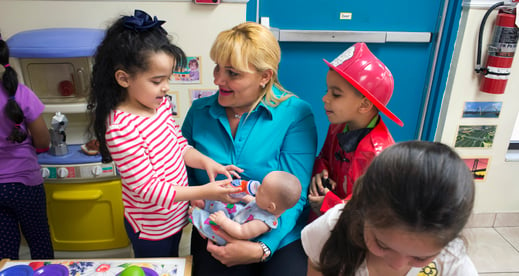
I was a kindergarten teacher for eight years at a public school. I loved my job, but somewhere along the road I started to become crotchety. I was often annoyed with my colleagues and frustrated with the demands of the district, and I was sure I knew better than any training or professional development session I would ever be forced to attend.
How could this have happened? When I began my career I was Little Miss Susie Sunshine. Teaching was exhausting, but I felt good about what I was doing. I could laugh with my students. It didn’t matter if kids weren’t sitting "crisscross applesauce," listening with perfect attention like little soldiers. I didn’t care about that. We were having fun! Center time was long and meaningful. We were learning to love learning together. It was great.
Losing Focus on What Matters
But gradually the expectations of other educators, leaders, and policy makers start to creep in on you as a new teacher. You feel like you're doing the school a disservice if you have students who sit on their knees to listen on the carpet or don’t raise their hands when sharing an answer. Center time is seen as a waste of instructional time. How backwards is that?! When did we start to adopt the attitude that children aren’t learning while playing? The attitude that play is fluffy and wasteful goes against every early childhood core education class I’ve ever taken both in undergraduate and graduate school.
Still, over time I found myself conforming to the herd. My students became little soldiers adhering to classroom expectations that really weren’t helping to serve learning and I their drill sergeant. I began teaching in a dual language classroom, and the poor children were lucky to receive 20 minutes of center time a day—not to mention the mere 15 minutes allocated for recess. Play was missing. Joy was absent.
I spent the bulk of my instructional time reminding my students of our classroom expectations, ensuring that everyone was “giving me five” at all times and dominating the classroom with teacher talk. I began to not enjoy teaching. With a regime like that, who would enjoy teaching? At the same time, I was looked upon as a model teacher by administrators. My evaluations were always impeccable. What I was really being evaluated on? The ability to set classroom expectations and write up lesson plans that followed district format?
Finally, after my eighth year I had had enough. I was through. Burnt out. Frustrated. A fellow teaching friend referred me to a job as a program evaluator at the University of Nebraska Medical Center. I was thrilled when I was offered the job. I would still be working in the field of education, but I could take a break from being an actual classroom teacher. Perfecto!
Finding Joy through Interactions
During my first few months in my new position, I was introduced to the CLASS® tool. Learning about this tool and its emphasis on teacher-child interactions was like being hit upside the head with a two-by-four. It summed up how I was teaching when I first began my career. What really hit home for me were two dimensions: Regard for Student Perspective and Language Modeling. Of course! We should allow students to take the lead in their learning! And YES we should allow for more intentional opportunities for promoting student talk, asking open-ended questions, and social conversations! Why have intentional strategies that support autonomy and language facilitation become so hard for us as educators?
Many will blame the demands of testing and assessment, which I agree plays a role. As educators, I think we also need to take some accountability for our actions. The assessments weren’t forcing me to act like a drill sergeant to five-year-olds. I had lost sight of what really mattered, Taking a break from teaching over these last few years is going to make me an awesome teacher when I’m ready to go back. In fact, I can’t wait until the day when I go back. I know the CLASS tool is going to make a huge impact on my teaching and interactions with children in the most wonderful ways.
